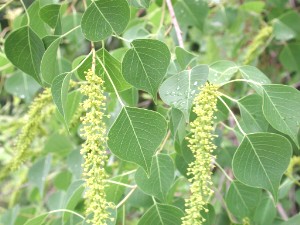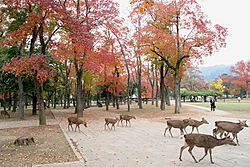Chinese tallow facts for kids
Quick facts for kids Chinese tallow |
|
|---|---|
 |
|
| Leaves and buds | |
| Scientific classification | |
| Genus: |
Triadica
|
| Species: |
sebifera
|
| Synonyms | |
|
|
The Chinese tallow tree (scientific name: Triadica sebifera) is a tree that comes from China and Taiwan. People call it by many names, like Chinese tallow, Florida aspen, chicken tree, or candleberry tree.
This tree is special because its seeds produce an oil called stillingia oil. This oil is used to make paints and varnishes. The fatty coating around the seeds is used to make candles and soap. That's why it's often called the "tallow" tree! It's also very good at producing vegetable oil, which can be used for biodiesel. In fact, it's one of the top three plants for oil production in the world.
Be careful though, the sap and leaves of this tree are known to be poisonous. Even its decaying leaves can harm other plants around it. Because it spreads so easily and can harm local plants, it's considered a harmful invasive plant in places like the southern United States.
Scientists have changed the name of this tree a few times. It used to be called Stillingia sebifera and then Sapium sebiferum. But now, its official scientific name is Triadica sebifera. The word sebifera comes from Latin words meaning "tallow-bearing," which describes how its seeds are used.
Contents
What the Chinese Tallow Tree Looks Like
This tree has simple leaves that fall off in autumn. They are shaped like a diamond or an egg, with smooth edges. Sometimes they look a bit like the leaves of the bo tree. The leaves are bright green on top and a lighter green underneath.
In autumn, these leaves turn beautiful colors like bright yellow, orange, purple, and red. It's quite a sight!
The Chinese tallow tree has both male and female flowers on the same plant. The flowers are greenish-yellow and white. They grow in long clusters, up to 20 centimeters (about 8 inches) long. You can easily spot them in the spring.
The female flowers are at the bottom of the cluster. They have three parts and no petals. The male flowers grow in groups higher up on the cluster.
The fruits of the tree are round capsules with three parts. When they are young, they are green. As they get older, they turn brown-black. The capsules then open up and release three round seeds. Each seed is about 12 millimeters (half an inch) wide and has a white, waxy coating. These seeds often hang on the tree for several weeks. In North America, the flowers usually bloom from April to June, and the fruits are ready from September to October.
Where the Chinese Tallow Tree Grows
The Chinese tallow tree is originally from China and Taiwan. It was brought to Japan a long time ago. Today, you can find it in many other places too, like the southeastern United States, Puerto Rico, Costa Rica, India, and southern France.
It's believed that Benjamin Franklin brought this tree to America during colonial times. Since then, it has spread and grown wild from North Carolina all the way down the Atlantic and Gulf coasts. It especially likes to grow in open fields, old farms, and along roadsides. It can even take over areas and form large groups of only tallow trees. In South Carolina, it is listed as an invasive species.
How People Use the Chinese Tallow Tree
The white, waxy part around the seeds is used to make soap. The oil inside the seed, called "stillingia oil," is poisonous but is used in industries.
The flowers produce a sweet liquid called nectar, which is not poisonous. This makes the Chinese tallow tree a very important plant for beekeepers. The honey made from its nectar is of high quality. Beekeepers often move their honey bees to areas with many tallow trees, especially along the Gulf Coast, to collect this honey in June.
This tree is also very pretty and grows quickly, making it a good shade tree. It looks especially nice in autumn when its leaves change to many bright colors, sometimes even more colorful than maple trees. It can grow in different types of soil and doesn't need perfect drainage. It also grows well in cities, even in tough spots like small tree pits along busy roads. It provides shade and a home for city animals like lizards and birds.
Why the Chinese Tallow Tree is Invasive
The Chinese tallow tree is considered an invasive species in many parts of the world, especially in North America. This means it's not native to these places and can harm the local environment. Tallow trees can spread very quickly and take over areas, pushing out native plants. When this happens, it creates a "monoculture," which means there's only one type of plant growing. This reduces the number of different plant and animal species in the area, making the ecosystem weaker.
These trees are very successful at invading new places because they grow fast and produce many seeds. According to the United States Department of Agriculture, tallow trees can start making seeds in just three years. A single tree can produce almost 100,000 seeds every year! These seeds can stay in the soil for several years before they sprout. Birds and water easily carry the seeds to new places.
It's also very hard to get rid of Chinese tallow trees. Their leaves and berries are poisonous, so not many animals eat them. They also regrow quickly, even if they are cut down. Currently, special plant killers (herbicides) and controlled fires are the main ways to manage them. Scientists are also studying a flea beetle that might help control the trees naturally.
In the Houston area of Texas, Chinese tallow trees make up a large part of all trees, more than any other species. The Texas Department of Agriculture lists it as one of the most invasive plants. It's even illegal to sell or bring Chinese tallow trees into Texas because of the harm they cause.
Images for kids
See also
 In Spanish: %C3%81rbol de sebo para ni%C3%B1os
In Spanish: %C3%81rbol de sebo para ni%C3%B1os






